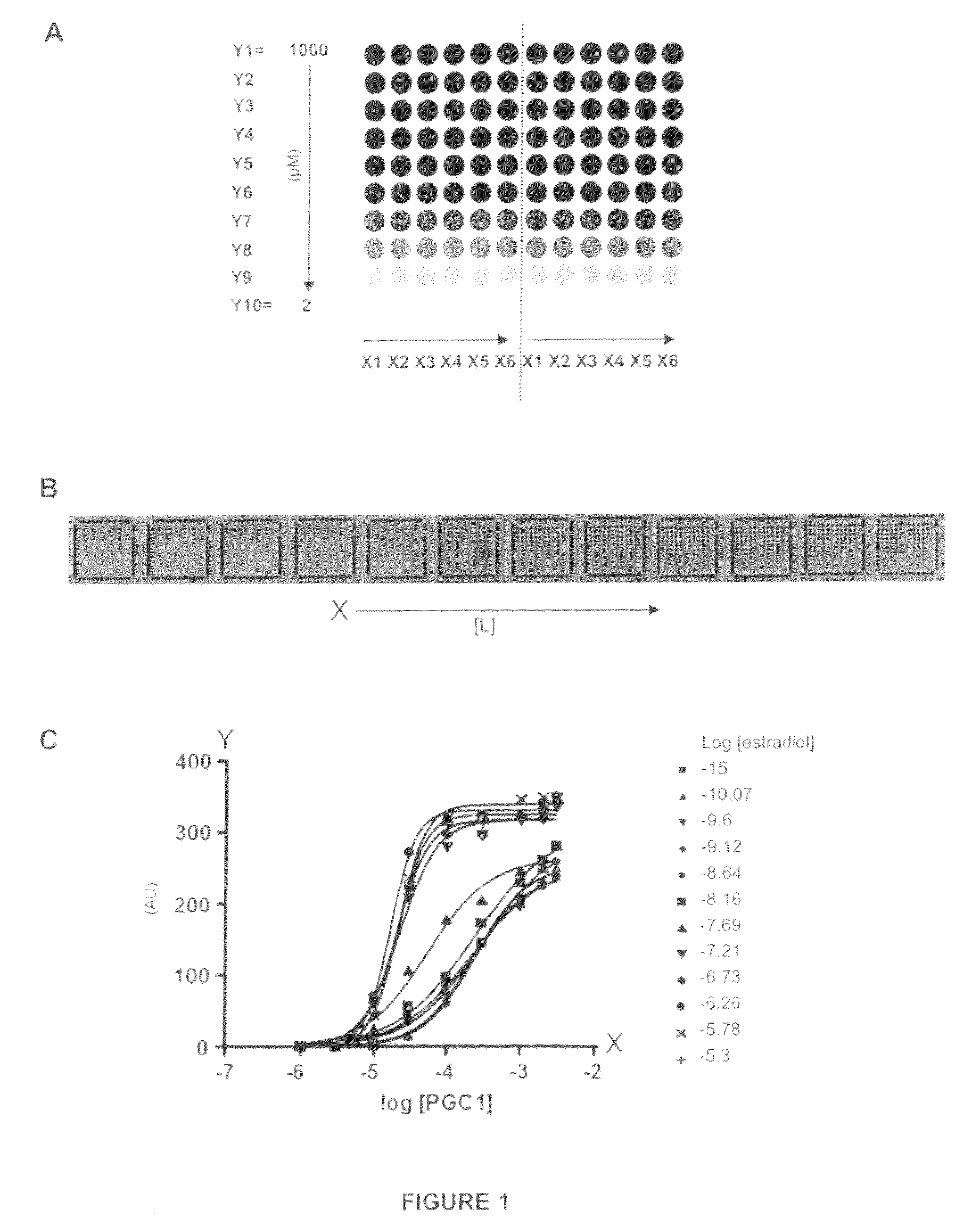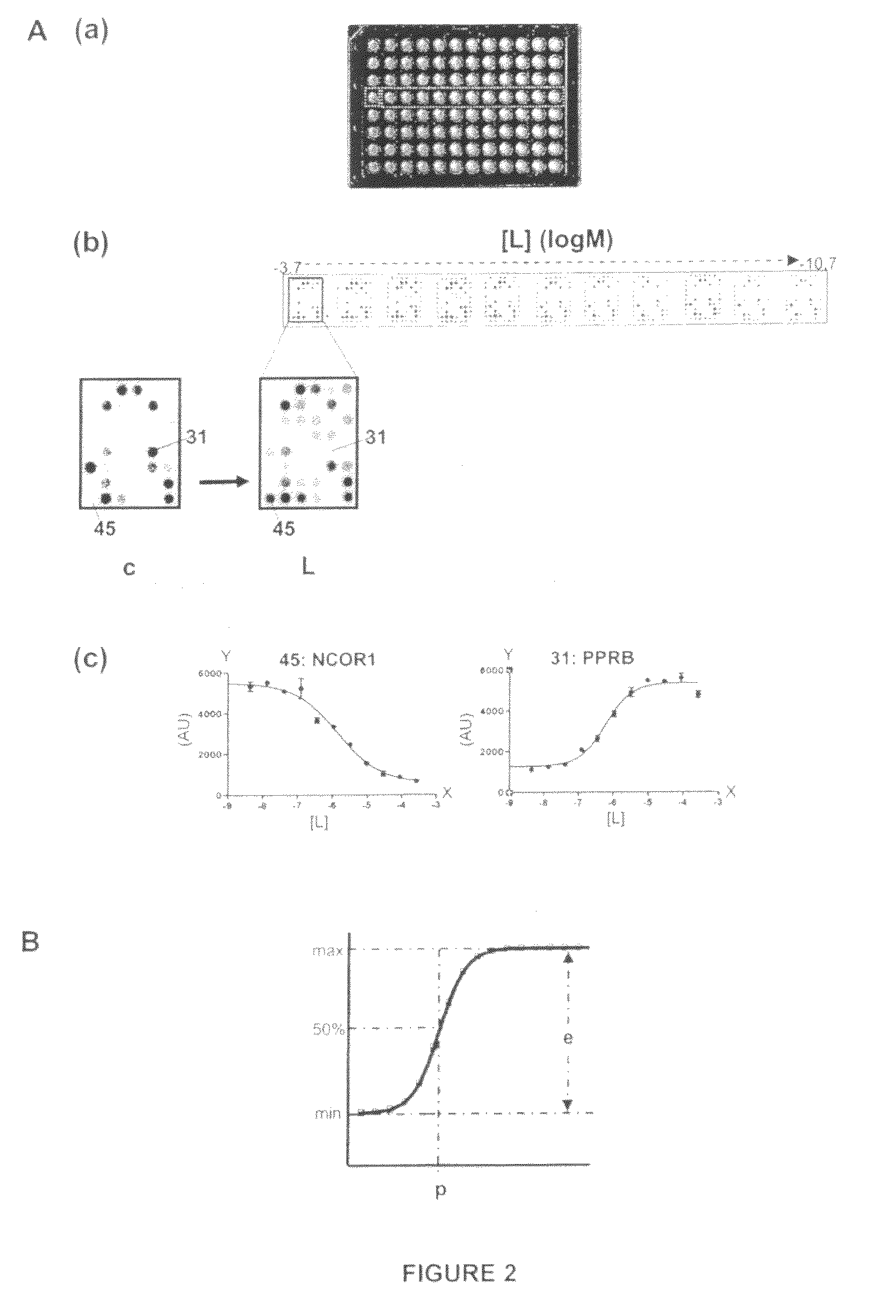Nuclear receptor assay
a technology of nuclear receptors and assays, applied in the field of assaying interactions, can solve the problems of difficult to obtain in high purity, cumbersome methods of zhou et al, time and sample consumption,
- Summary
- Abstract
- Description
- Claims
- Application Information
AI Technical Summary
Benefits of technology
Problems solved by technology
Method used
Image
Examples
example 1
Investigation of the Effect of Estradiol on the Binding Affinity of the Estrogen Receptor (ER) in Interactions with a Variety of Co-Regulator Peptides—Simultaneous Testing of Multiple Co-Regulator Concentrations in one Sample of Nuclear Receptor and Ligand
[0109]The PamChip® microarray technology was used to generate binding curves of the Estrogen Receptor (ER) interacting with 6 different peptides derived from co-regulator proteins.
[0110]Such binding curves are useful to investigate the effect of a ligand or drug (here estradiol was used as example) on the binding affinity of the Estrogen Receptor interaction with co-regulator peptides. Typically, the effect may be measured by two parameters: potency of the ligand and efficacy of the ligand. For accurate determinations of these parameters, the binding profiles need to be measured at different peptide concentrations, at different ligand concentrations, at a single receptor concentration. Such assays proved to be very laborious, time-...
example 2
Determination of Ligand Potency and Efficacy of a PPAR Gamma Ligand in the Interaction of PPAR Gamma with 53 Different Co-Regulator Derived Peptides
[0116]The PamChip® microarray technology was used to generate simultaneously efficacy and potency values of a PPAR gamma ligand GW1929 (Sigma Aldrich) modulating the interactions of PPARG-LBD with 53 different co-regulator derived peptide motives. This generates, for the compound of interest, a potency profile as well as an efficacy profile. Such two-parameter profiles are useful both to characterize nuclear receptor ligands and to compare the ligands based on the differences and similarities in their effect on binding of the receptor to different motives (see also Example 6).
[0117]As mentioned in Example 1, a ligand is typically characterized by two parameters: potency of the ligand and efficacy of the ligand. For accurate determinations of these parameters, the binding profiles need to be measured at different peptide-concentrations, a...
example 3
Kinetics of Binding of the Glucocorticoid Receptor (GR) in Interactions with a Variety of Co-Regulator Peptides—Testing of Multiple Assay Time Points, and Multiple Co-Regulator Derived Peptides in One Sample of Nuclear Receptor and Ligand
[0122]The PamChip® microarray technology was used to generate time curves of ligand-induced binding of the glucocorticoid receptor (GR). The ligand of interest was dexamethasone. Such time curves are useful to investigate the effect a ligand or drug on the kinetics of binding of the nuclear receptor with co-regulator peptides. Additionally, time-curves improve the accuracy and statistics of the measurement. Moreover, kinetic measurements improve the power to discriminate interactions with different peptides.
[0123]For accurate determinations of kinetic parameters, time curves need to be generated, and for multiple peptide motifs. Therefore binding need to be measured at multiple different time points using multiple different peptide motifs, both in t...
PUM
| Property | Measurement | Unit |
|---|---|---|
| molecular weight | aaaaa | aaaaa |
| vacuum pressure | aaaaa | aaaaa |
| thicknesses | aaaaa | aaaaa |
Abstract
Description
Claims
Application Information
 Login to View More
Login to View More - R&D
- Intellectual Property
- Life Sciences
- Materials
- Tech Scout
- Unparalleled Data Quality
- Higher Quality Content
- 60% Fewer Hallucinations
Browse by: Latest US Patents, China's latest patents, Technical Efficacy Thesaurus, Application Domain, Technology Topic, Popular Technical Reports.
© 2025 PatSnap. All rights reserved.Legal|Privacy policy|Modern Slavery Act Transparency Statement|Sitemap|About US| Contact US: help@patsnap.com



